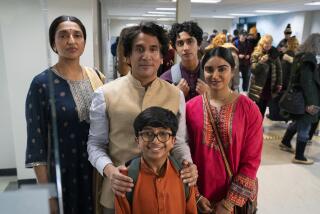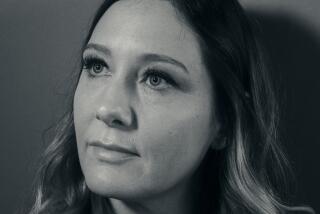How Mindy Kaling brought the Hindu tradition of Ganesh Puja to American TV
- Share via
On a balmy day last August, a rare production was unfolding on the grounds of Taft Charter High School in Woodland Hills.
Inside the school’s gymnasium, marigolds and brass bells were in heavy supply; swaths of magenta, saffron and burgundy fabrics draped the walls; and garlands hung on a life-size idol of Lord Ganesh, the elephant-headed deity, that held court at the front of the room. The space would soon be filled with dozens of actors in shimmering saris and kurtas. Some would kneel, head to the ground, to portray the act of praying.
This is Ganesh Puja. Or, at least, “Never Have I Ever’s” version of Ganesh Puja.
According to Giriraj Bhandari, a Hindu priest who served as a consultant on the episode, Ganesh Puja is a ritual performed at the start of any significant work to remove obstacles likely to be encountered. Ganesh Puja, which can be performed at any time, is also traditionally performed on Ganesh Chaturthi, an annual Hindu celebration honoring the birth of Ganesh. (Series co-creator Mindy Kaling says that “Never Have I Ever” uses the terms Ganesh Puja and Ganesh Chaturthi interchangeably.)
“I guess on some level I thought, if I’m going to see any reflections of my childhood religious experience reflected on TV, I’m going to have to just do it myself,” Kaling said during a break from production at the school, which stands in for the show’s fictional Sherman Oaks High School.
For her new Netflix series “Never Have I Ever,” Mindy Kaling picked Canadian teen Maitreyi Ramakrishnan from an open call of 15,000 hopefuls.

It’s not the first time Kaling, who created the series with Lang Fisher, has sought to bring diverse depictions into the mainstream. Some kind of Indian ceremonial event is in most of the shows she has worked on: “The Office” featured an episode set at a celebration of Diwali, the Hindu festival of lights; “The Mindy Project” included a mundan ceremony, a traditional Hindu ritual in which a baby’s hair is shaved off in the belief that it purifies the child; and “Four Weddings and a Funeral” depicted a Muslim wedding.
In the “Never Have I Ever” episode “... Felt Super Indian,” directed by Linda Mendoza and written by Kaling, Devi (Maitreyi Ramakrishnan) and her family celebrate Ganesh Puja, which the show’s regional Hindu Association is holding at Devi’s high school, for the first time since her father’s death. It’s one big eye-roll for Devi, who would rather do anything else. But reflection comes later, while she prays. Instead of her hoping for trivial things like getting into a good school or having a bigger bra size, she thinks of playing pingpong with her father.
“It’s been really fun,” Kaling said, seated inside the school’s gymnasium. “But it’s also this huge responsibility because my experience growing up Indian American and Hindu is very different than other Hindu American experiences. It’s very different from like Indian Hindus in India’s experience, [from] Canadian Hindus. And so, we’re just doing, like, a version of it that was very true to my childhood through the eyes of this character, Devi.” (Some viewers have found fault with some details in the episode, including a montage that erroneously features stock footage from another festival.)
The episode explores Devi’s struggle with her identity as the daughter of immigrants and her reluctance to let her Indianness to stand out. Her feelings of embarrassment about her culture are challenged by two friends — one who thinks the Bollywood dance unfolding outside is not lame; and another, home on break from college, who shares how he learned to embrace his cultural traditions after meeting someone at school who proudly continued his own.
Kaling pulled from her own life and the disconnect she often felt, particularly while participating in religious rituals like Ganesh Puja, which involve chants in Sanskrit, the ancient language of Hinduism.
“I remember thinking as a kid, ‘Oh, this is really distancing. I don’t know what I’m saying. What’s the point?,’” Kaling said. “I always felt like, ‘Well, that’s an interesting thing to, like, fully kneel in front of a statue and pray and ask for good things for your family while someone is chanting something that you don’t understand while incense is burning.’ It was only later, when I got older, that I saw the beauty of it — the growth and comfort that you get from being part of something like that.”
It’s the episode that Ramakrishnan, who is Tamil Canadian, cites as the one she relates to the most because it captures what it’s like to be caught between worlds.
“I remember when I was in grade three, a girl asked me, ‘Where are you from?’ And I said, ‘Canada.’ She’s like, ‘No, where are you from?’ And I’m like, ‘No, I’m... I was born in Canada, Mississauga,’”Ramakrishnan recalled. “And then she kept asking me and I got so mad, I started to cry. It’s an important conversation to have. And it’s not something that you only go through when you’re 15 like Devi.”
The episode features cultural touches like a rangoli, a colorful design, on the floor at the entrance of the space. Anjul Nigam, the actor who plays Pundit Jay in the episode, had to take ancient Sanskrit pronunciation lessons. And the show’s costume designer, Salvador Perez, had to dress 150 background actors, buying some apparel from Frontier Heritage and Sona Chaandi in Artesia.
“It looks like a Crayola box exploded,” Rodriguez says of trying to have a variety of colors and designs for the saris and kurta suits.
For Kaling, the hope is that Indian people feel seen by having their culture depicted on screen.
“I’m always psyched whenever it’s Diwali time, when I hear Indian people are watching [‘The Office’] episode the way that they some people watch a Christmas episode,” she said. “And if [‘Never Have I Ever’s’] Ganesh Puja episode could become something like that, that would be my dream.”
More to Read
The complete guide to home viewing
Get Screen Gab for everything about the TV shows and streaming movies everyone’s talking about.
You may occasionally receive promotional content from the Los Angeles Times.







